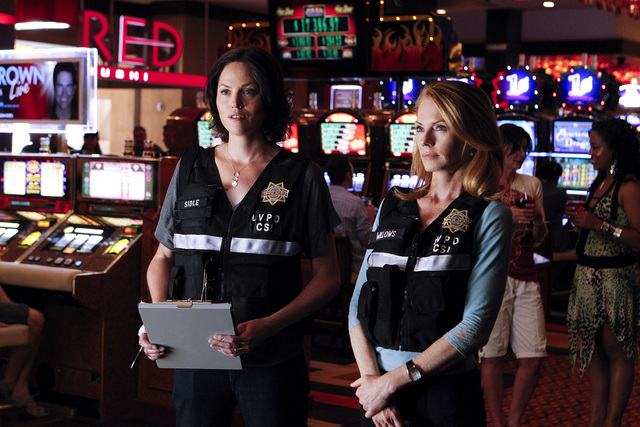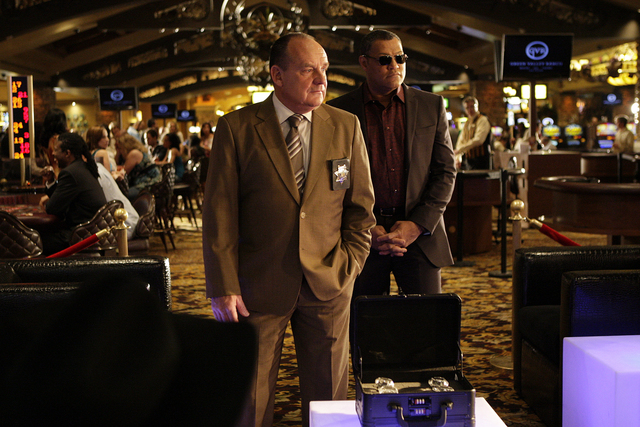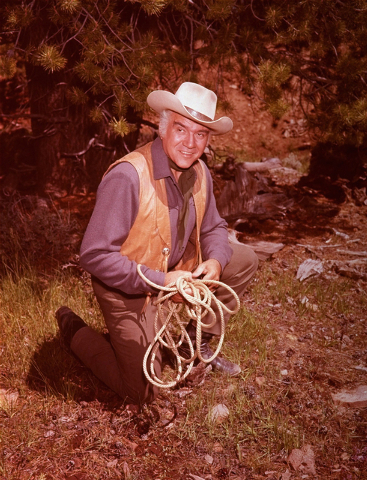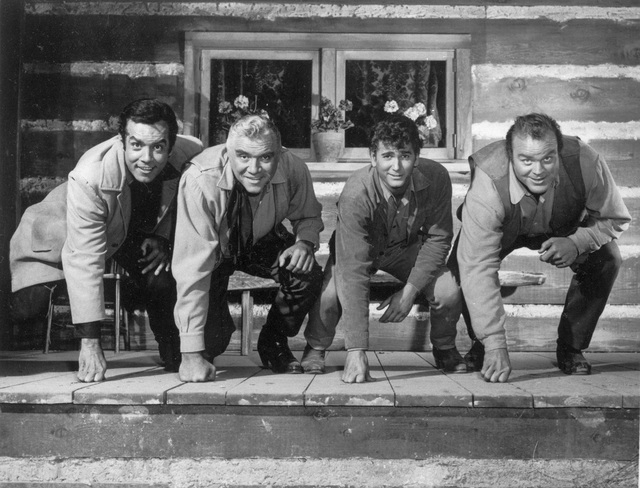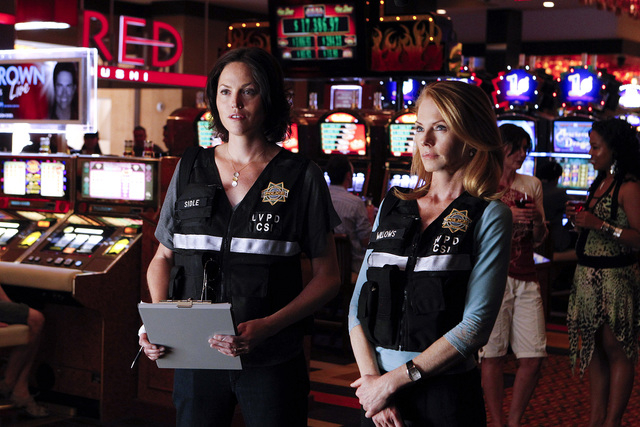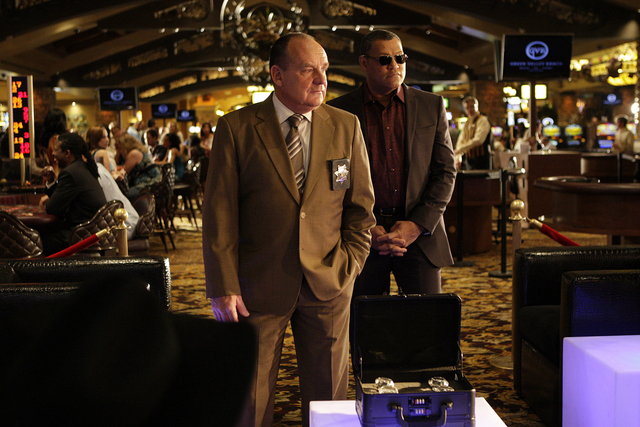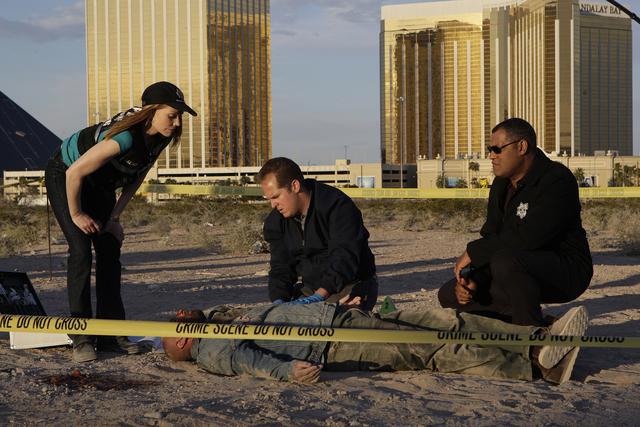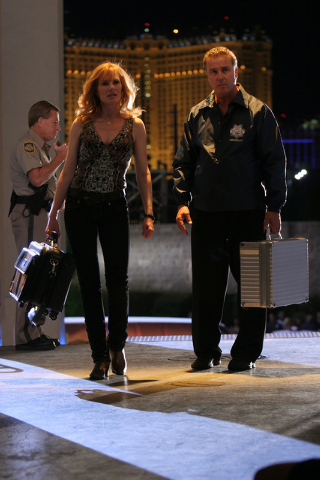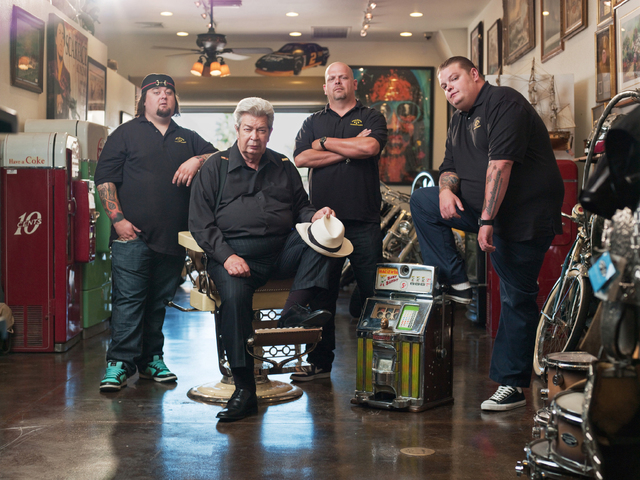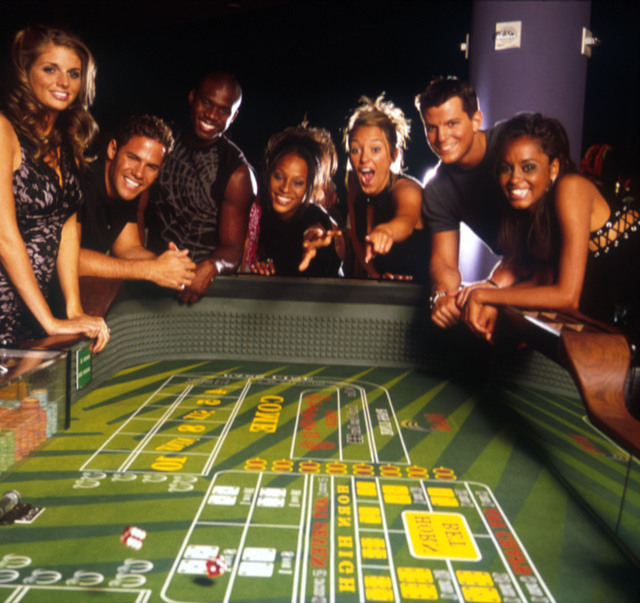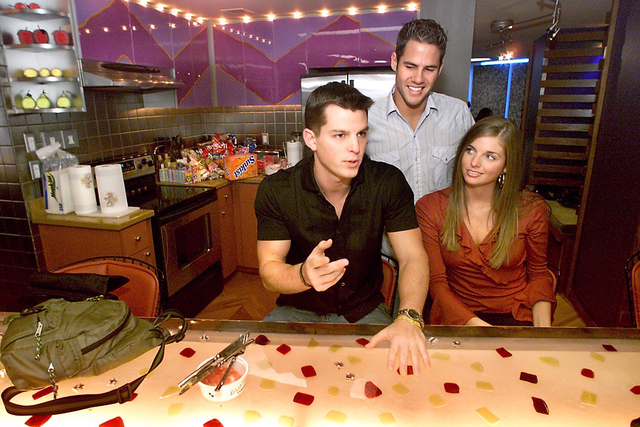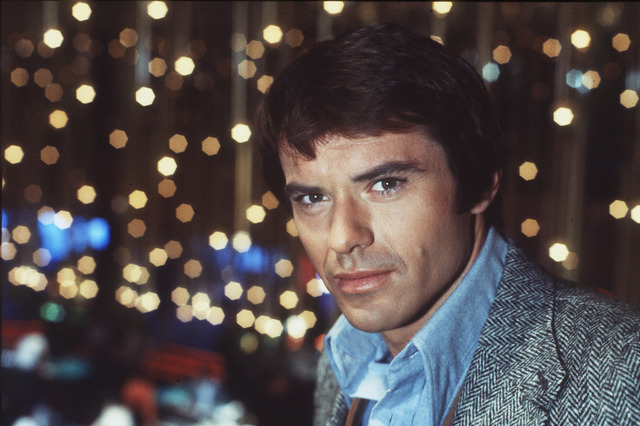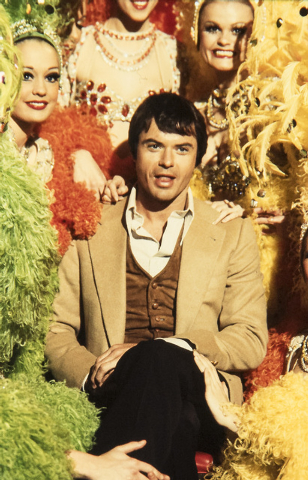Nevada’s TV boom began in ‘Vega$’
Editor’s Note: Nevada 150 is a yearlong series highlighting the people, places and things that make up the history of the state.
It always comes back to Dan Tanna.
By 1978, other TV series had called Nevada home. Actor Rod Cameron patrolled the far reaches of the Silver State from 1956-59 on the syndicated “State Trooper.” And the Cartwrights worked the Ponderosa ranch near Virginia City from 1959-73 on NBC’s “Bonanza,” which remains among the 10 longest-running scripted series in American history.
But something about “Vega$” — with its private detective who lived in a casino’s prop warehouse, drove a flashy ’57 Thunderbird and parked it in his living room — appealed to a generation of young males.
“He was just cool,” Palms founder George Maloof says of Robert Urich’s Tanna. “He always had plenty of ladies. And he was cruising up and down the Strip getting the bad guys.”
“My earliest memory of television really is ‘Vega$,’” says “CSI” creator Anthony Zuiker, who was 9 when it premiered. “We would watch the show primarily to see if we could recognize the Vegas landmarks in the background or the casinos for the walk-and-talks with Dan Tanna. It was the coolest memory as a kid.”
“Vega$” only lasted three seasons, from 1978-81 on ABC. But both Maloof and Zuiker credit the show’s influence on the overlapping television booms that would bring Las Vegas to the world and help bring the world to Las Vegas.
“When we look at our research,” says Cathy Tulle, senior vice president of marketing for the Las Vegas Convention and Visitors Authority, “we know that 74 percent of our leisure travelers who were surveyed said that TV programs that feature Vegas are influential in their decision to visit.”
THE RISE OF ‘REALITY’
Look to your left.
Now, look to your right.
If you’re reading this somewhere in the Las Vegas Valley, there’s a decent chance someone in your field of vision has a reality show.
Over the years, there have been at least 40 unscripted series based in Southern Nevada, not counting the dozens that come for an episode, an elimination round or an entire season.
A spreadsheet provided by the Nevada Film Office shows 663 film permits issued for reality shoots between 2005, the first year of electronic records, and the end of September. That doesn’t even count shows filmed on private property, including casinos, where permits aren’t required.
The shows that obtained them, though, range from NBC’s “America’s Got Talent” to DIY’s “Yard Crashers” — no series starting with the letter Z applied — with plenty of Kardashians and Housewives, poker players and aspiring chefs in between.
It started with the true story of seven strangers picked to live in the Palms and have their lives taped to find out what happens when people stop being polite and start getting real.
After being rejected by casinos up and down the Strip, producers of MTV’s “The Real World” were just about to settle for a house on the west side of town. Then Maloof stepped in and offered them the use of his under-construction resort.
“I think there was just a paranoia back then of letting a camera into a casino,” he says of his competitors’ reluctance. “They were just over 21, but seven younger adults with a camera, kind of free-will, running around a casino didn’t really turn a lot of people on.”
Plenty of viewers, though, were turned on by the result. The show’s 12th season, debuting in September 2002, was the first where the cast simply went nuts. Instead of confronting issues like race relations and the AIDS epidemic as previous casts had, “The Real World: Las Vegas” houseguests were more interested in drunken hookups, including a memorable threeway in a bathtub.
“We ruined ‘The Real World,’” cast member Steven Hill told the Review-Journal in 2007, when that season’s participants reunited for a miniseries. They remain the only cast in the show’s 29 seasons to be reassembled. (A new cast moved into the Hard Rock Hotel in 2011.)
Maloof was a fan of the series. But more importantly, he was a fan of “Vega$.” He was a 13-year-old living in Albuquerque when Dan Tanna first hit the airwaves, and whenever the young Maloof came to Las Vegas, he’d try to find sites featured on the series. It seemed reasonable to assume “Real World” fans might do the same.
“I think everybody kind of understood a few months after it aired that it was beneficial to the property,” he recalls. “Then it just started. Then it was crazy.”
Before long, the Palms was home to the tattoo series “Inked,” the Jenny McCarthy-hosted “Party @ the Palms,” “Sunset Tan” and “Bachelorette Party: Las Vegas.” MTV’s Video Music Awards and spring break coverage also settled in at the hotel.
Other casinos soon took notice, with series set at the Golden Nugget (“The Casino”), Green Valley Ranch (“American Casino”), Caesars Palace (“Caesars 24/7”), Hard Rock (“Rehab: Party at the Hard Rock Hotel”), South Point (“Vegas Stripped”) and Binion’s (“Casino Confidential”).
From there, the shows flooded the valley, making stars of various wattage out of car guys (“King of Cars,” “Vegas Rat Rods”) and tattooed guys (“Bad Ink”), sex workers (“Gigolos,” “Pleasure for Sale,” “Hookers: Saved on the Strip”) and strippers (“King of Clubs,” “Show Us Your Wits”), ghost hunters (“Ghost Adventures”) and thrift hunters (“Thrift Hunters”), aquarium builders (“Tanked”), house flippers (“Flipping Vegas”), body painters (“Naked Vegas”) and polygamists (“Sister Wives”), to name a few.
But the biggest discovery was the three generations of the Harrison clan, and an offbeat family friend, at Gold &Silver Pawn. At last count, “Pawn Stars” airs in more than 160 countries, and it’s launched the local spinoffs “American Restoration” and “Counting Cars” as well as the locally produced game show “Pawnography.”
“You know what? I’m proud of that whole deal,” Maloof says of his stint as the canary in the city’s reality coal mine. “I do look at it sometimes and go, ‘I wonder if we turned that down if this would be happening right now.’ And even the way Las Vegas presented itself (as a 24-hour party) after that, I wonder if that would be the case.”
FLIPPING THE SCRIPT
A reality show even played a vital role in Nevada’s biggest scripted success.
Aside from “Bonanza,” “Vega$” and “Crime Story,” the mob drama from “Vega$” creator Michael Mann that aired on NBC from 1986-88, the Silver State was once littered with failed series.
Caesars Palace was the setting for both Aaron Spelling’s “Love Boat”-esque “Hearts Are Wild” (1992, CBS) and the buddy detective drama “The Strip” (1999, UPN). The failed “Happy Days” spinoff “Blansky’s Beauties” (1977, ABC) and the disastrous “Cheers” spinoff “The Tortellis” (1987, NBC) briefly called Las Vegas home. Dennis Franz and Benjamin Bratt kept the city’s streets safe, at least for a few weeks, on “Nasty Boys” (1990, NBC). And big-booty-lovin’ rapper Sir Mix-A-Lot hosted the Strip-centric anthology series “The Watcher” (1995, UPN).
Then Zuiker, the Mirage tram driver who graduated from Chaparral High School and UNLV, stumbled across an episode of Discovery Channel’s “The New Detectives” and became fascinated with forensic science. In 2000, “CSI: Crime Scene Investigation” was born. It, too, received precious little love from the Strip.
“Most casinos were very, very resistant to having ‘CSI’ shoot inside of them. We got as far as exteriors to several casinos, just for promotional purposes,” Zuiker recalls. “Because the sensitivity back then was, ‘People don’t die in hotels in Las Vegas. And, for that matter, people don’t die in Las Vegas, period.’ It was pretty much across the board.”
But when viewership took off, Zuiker credits locals casinos, including the Rampart and Green Valley Ranch, for realizing the marketing potential.
“These places began to go, ‘You know what? If you’re going to put us in front of 20 million people, hang these bodies from the rafters. We don’t care. Just get in here and shoot.’”
That 20 million only represented viewership in the U.S. In 2012, “CSI” was named the most-watched series in the world for the fifth time in the past seven years. According to Zuiker, someone is watching it somewhere in the world every second, with a daily audience of 70.8 million people.
Other Nevada-based series soon followed, but only two had any staying power. “Las Vegas,” set at the fictional Montecito resort — a location that moved up and down the Strip and back again, sometimes seemingly during the course of a single episode — ran from 2003-08 on NBC. And “Reno 911” spoofed “Cops” from 2003-09 on Comedy Central.
Among the one-season wonders were the poker comedy “Lucky” (2003, FX) and the poker drama “Tilt” (2005, ESPN). Ben Affleck co-created the interactive mystery “Push, Nevada” (2002, ABC), but it couldn’t lure viewers despite a $1 million prize. In a case of unfortunate timing, the animated “Father of the Pride” (2004, NBC) focused on the comic adventures of Siegfried &Roy’s lions less than a year after Roy Horn’s mauling.
After getting a taste of the hundreds of millions of dollars generated by “CSI,” CBS kept going back to the Southern Nevada well with Rob Lowe in “Dr. Vegas” (2004), the Hugh Jackman-produced musical drama “Viva Laughlin” (2007), Jim Belushi and Jerry O’Connell as Vegas lawyers in “The Defenders” (2010) and Dennis Quaid as legendary Clark County sheriff Ralph Lamb in “Vegas” (2012).
Zuiker refused to see it as a case of others, even his own network, trying to dilute his success.
Speaking a few days after “CSI” surpassed “Bonanza” by kicking off its 15th season, he insists he’s never been territorial about his hometown’s TV legacy.
“No, no. Not at all. Never. No. I would never take that responsibility.
“The thing is,” he concludes, “we’re all standing on the shoulders of everybody else. So there would be no ‘CSI’ without Dan Tanna and ‘Vega$.’ ”
Contact Christopher Lawrence at clawrence@reviewjournal.com or 702-380-4567.



